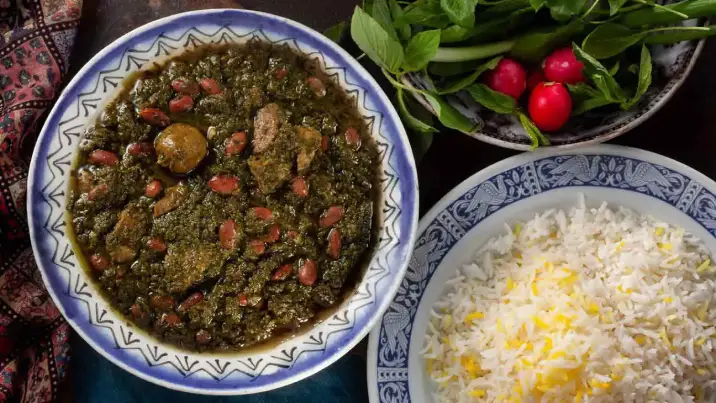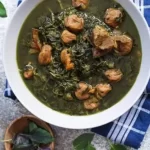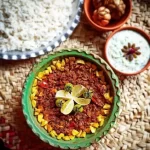Traditionally the first Saturday of Azar, the ninth month of the Solar Hijri calendar, is known as the National Ghormeh Sabzi Day. Ghormeh Sabzi is the hallmark of Persian cuisine that dates back more than 2000 years ago.
It is one of the rare dishes within Persian cuisine that has kept its original nature. “Ghormeh” or “Korma” derives from the Turkish term “Kavurma” which refers to a dish with “braised meat.”

The meat is slow-cooked with some vegetables and beans for Ghormeh Sabzi. Because of the high nutritional value of Ghormeh Sabzi, it is a dish that is both healthy and delicious.
You can serve Ghormeh Sabzi on both formal and informal occasions. You can cook Ghormeh Sabzi and invite your loved ones for a home-cooked meal that is prepared with love while, at the same time, entertaining their palate to the fine-dining experience of three-starred restaurants. If cooked properly, nothing beats Ghormeh Sabzi when it comes to its taste and texture as a dish.
If you are one of those Ghormeh Sabzi lovers who don’t know how to cook it best, you have come to the right place. Follow this Ghorme sabzi Recipe to master the art of cooking Iranian Ghormeh Sabzi.
Read more: Advieh; Persian Spice Blend Recipe

Ghormeh Sabzi Ingredients
| Ingredient | Quantity |
|---|---|
| Lamb | ½ kilo |
| Onion | 1 medium-sized |
| Parsley, Coriander, cilantro, and Leeks | 200 grams of each |
| Fenugreek greens | 50 grams |
| Dried Fenugreek | 2-3 tablespoons |
| Spinach | 50 grams |
| Dried Persian Lime | 3 small-sized |
| Tomato Paste | 2 tablespoons (optional) |
| Kidney Beans | 200 grams |
| Salt, Pepper, Turmeric, Oil | To taste |
Note1: Traditionally and in most regions of Iran, Spinach and Chive leaves are used within Ghormeh Sabzi; however, if you are allergic to it or don’t like its taste, you can remove Spinach from the recipe for Ghormeh sabzi.
Note2: Dried Lime is a traditional Persian and Turkish spice that gives a sour taste to the dish. Note that you must remove the dried limes from the pot when the dish is ready. If you don’t remove them, their bitter taste might ruin your dish entirely.
Regional Variations of Ghorme Sabzi
Different regions within Iran may have their own unique spin on Ghormeh Sabzi. For instance, some ghormeh sabzi recipes with dried herbs include the addition of dried fenugreek leaves (kasuri methi) or fresh mint leaves for an aromatic touch.
Other variations may introduce ingredients like pomegranate molasses or a hint of cinnamon, offering distinct regional flavors. Exploring these regional variations can provide a deeper appreciation for the diversity within Iranian cuisine.
Persian Ghormeh Sabzi Recipe
Step One
First, you need to soak the kidney beans in water for a couple of hours to make them lose their firm texture and become softer. This step is necessary since if you don’t soak them first, the beans will not get cooked properly, and you will be left with chewy and hard-to-swallow beans in your dish.
Step Two
Wash the fresh herbs and chop them well. Don’t chop the herbs too small since if they are chopped too small, it will damage the dish’s consistency.
Step Three
Place a pan on the stove and add the vegetables to the pan. Stir fry the vegetables in vegetable oil. Once the vegetables lose their original green color and turn into a dark green color, you can remove them from the pan.
Note3: You can add some tomato paste to the herbs while frying; however, this step is optional, and some may choose not to add the tomato paste at all.

Step Four
Place a large pot on the stove. Add some oil and turn up the heat. Chop the onions into small bits and then add them to the hot oil. Stir till the onions slightly turn into a golden brown color.
Step Five
Chop the lamb into small bits and add it to the onions. Add salt, pepper, and turmeric, and continue stirring. You do not need to fry the meat completely at this stage. You only need to stir the meat in hot oil and onions for 2-3 minutes till it loses its raw texture and gets a little crispy on the outside.

Step Six
Once the color of the meat is changed, add the vegetables to the put and start stirring. After stirring for 2-3 minutes, add some cups of boiling water to the mixture. Turn up the heat and wait till the water starts boiling. Once the water starts boiling, reduce the heat to medium and close the lid and let it cook.
Note4: The time it takes for the lamb to cook varies depending on which cut of lamb you use for the dish. Loin chops are the best option for Ghormeh Sabzi, and it usually takes at least 3-4 hours for them to cook properly.
Step Seven
After 3-4 hours, open the lid and taste the meat if it is perfectly cooked, it is now time to add the beans. Add the beans, dried Persian limes, and some dried Fenugreek to the pot and let it cook for at least another hour. Once the water is reduced and the dish reaches the right consistency, it is ready.

Khoresh Ghormeh Sabzi is a dish that could be served both as a launch and dinner. Traditionally, it is served with cooked Basmati rice. This authentic ghromeh sabzi recipe is designed to serve 4 people, and if you are willing to serve more people, you can use more ingredients (e.g. you can double the amount mentioned in the recipe if you are willing to serve 8 people). Normally, it does not take more than 3 hours for the dish to become ready to serve; however, if you realize that the dish does not have the consistency that you want, you can leave it on the stove for a bit longer till the water is reduced, and you get the right consistency for Ghormeh Sabzi.
Additional Notes on Persian Ghormeh Sabzi Recipe
- You can add lamb bone broth to the dish to give it a rich and more delicious taste. Using lamb bone broth will also boost the nutritional value of the dish to a significant degree. You can use lamb bone broth in any dish in which the meat is slow-cooked since it boosts the dish’s consistency.
- If you do not have access to lamb or do not prefer its taste, you can use chicken instead.
- Normally, red Kidney beans are used in Ghormeh Sabzi. However, you can use Pinto beans in Ghormeh Sabzi as well. Some even believe that using Pinto beans in Ghormeh Sabzi might boost its taste, but you can choose either of them based on your palate.
- Do not add too much salt when frying the meat with the onions at first, because it might prevent the meat to get cooked properly. You may add more salt at the final stages of the dish getting prepared if you feel the need.
- If you do not have access to dried limes, you can use ground dried lime instead.
- Since the stock needs to get reduced properly to reach the right consistency for the dish, once you add the water to the meat and beans, make sure to add enough water at first so that you do not have to add more while the dish is getting cooked. And Under no circumstances add cold water to the dish while it is getting prepared; if you realize you need to add more water, add hot and boiling water.
- To get the dish’s right consistency sometimes it helps to remove the pot from the stove for a couple of minutes and then put it on again. This practice is proven to boost the consistency of the dish.
Vegetarian/Vegan Ghormeh Sabzi
For those following a vegetarian or vegan lifestyle, Ghormeh Sabzi can be easily modified. Replace the meat with plant-based protein alternatives such as tofu, tempeh, or seitan. Sauté the herbs and vegetables as instructed in the khoresh ghorme sabzi recipe, and then add your choice of vegetarian protein. Adjust the cooking time accordingly, as plant-based proteins generally require less cooking than meat. Additionally, use vegetable broth instead of meat broth to maintain the desired dietary preferences.
Variations of Persian Ghormeh Sabzi
Ghormeh Sabzi is traditionally made in Iran using bone-in lamb shoulder or leg slices. Feel free to swap out the beef if you’d rather eat lamb and can find a high-quality cut.
To account for the weight of the bones, simply increase the quantity of lamb used; for the recipe below, 2 to 2 1/2 pounds should be plenty.
What Are Dried Limes and Where to Find them?
Dried limes, also called Limoo Amani, are limes that have been brined and then sun-dried. They come from Oman, which is where they originated, thus the Persian term Limoo (lime) Amani (Oman). They are added whole after being poked to allow their acidic and musky taste to seep through.
There are two types of dried limes: brown and black. Either one is acceptable. They are bitter, so it’s okay to leave them behind, however some brave Iranians consume them with the stew. To release more acidity, most people merely give them a gentle squeeze; be careful not to shatter them though, since their bitter seeds may fall out.
Dried limes are available online, in Middle Eastern Markets, and at some specialist food stores. Their distinct taste adds something special to this stew. I wouldn’t attempt using an other spice in place of it. However, you may always use fresh lime juice if you don’t like dried limes or can’t locate them.
Serving Suggestions of Ghormeh Sabzi
While Ghormeh Sabzi is traditionally served over steamed basmati rice, there are other ways to enjoy this flavorful stew:
- Try serving it with Persian flatbread (naan) or lavash for a delightful combination.
- For a complete meal, serve Ghormeh Sabzi alongside a refreshing Shirazi salad, which combines cucumbers, tomatoes, onions, and fresh herbs dressed with lemon juice and olive oil.
- Accompany the stew with Mast-o-Khiar, a cooling yogurt and cucumber dip, to balance the flavors.
How to Store Ghormeh Sabzi
For up to three days, store any leftovers in the refrigerator in an airtight container. Ghormeh Sabzi can also be frozen for a maximum of three months. Any prepared food should always be fully cooled before being placed in the refrigerator or freezer. Place in a saucepan over low heat or reheat in the microwave until very hot.
FAQs on Persian Ghormeh Sabzi Recipe
- What is Persian Ghormeh Sabzi?
Persian Ghormeh Sabzi is a traditional Iranian stew made with a combination of fresh herbs, vegetables, and meat. It is often prepared with sautéed herbs such as parsley, cilantro, and fenugreek leaves, along with onions, kidney beans, and small pieces of meat, usually beef or lamb. This flavorful stew is typically served over steamed rice and is a popular dish in Iranian cuisine.
- How do I make Ghormeh Sabzi vegetarian or vegan?
To make a vegetarian or vegan version of Ghormeh Sabzi, you can replace the meat with plant-based protein alternatives such as tofu, tempeh, or seitan. Simply sauté the herbs and vegetables as instructed in the traditional ghormeh sabzi recipe, and then add your choice of vegetarian protein. Adjust the cooking time accordingly, as plant-based proteins typically require less cooking time than meat. Also, make sure to use vegetable broth instead of meat broth to maintain the vegetarian or vegan status of the dish.
- Can I use dried herbs instead of fresh ones?
While fresh herbs are traditionally used in Ghormeh Sabzi to achieve the authentic flavors, you can use dried herbs as a substitute if fresh ones are not available. However, it’s important to note that the taste and aroma may differ slightly.
- How long does Ghormeh Sabzi take to cook?
Typically, the dish takes around 2 to 3 hours to cook on low heat. The longer cooking time helps tenderize the meat and allows the herbs and spices to infuse the stew with their rich flavors.
- Can I make Ghormeh Sabzi in advance or freeze it?
Yes, Ghormeh Sabzi is a great dish to make in advance or freeze for later consumption. In fact, the flavors of Ghormeh Sabzi tend to deepen and improve when allowed to sit overnight.
If you have not made Khoresht Ghormeh Sabzi before, this recipe is designed to help you every step of the way. Do not hesitate to try it for yourself. Follow the recipe, and create a great and delicious experience of Persian cuisine for your loved ones.
Persian Ghormeh Sabzi Recipe (Persian Herb Stew)
Course: Main coursesCuisine: Persian FoodDifficulty: Medium5
servings30
minutes4
hours320
kcalGhormeh Sabzi is a Persian herb and kidney beans stew that could be served both as launch and dinner. It is served with cooked Basmati rice.
Ingredients
½ kilo lamb
1 medium-sized onion
3 small-sized dried lime
2 tablespoons of tomato paste
200 grams of kidney beans
Salt, pepper, turmeric, and oil to taste
- Special Ghormeh Sabzi herbs
Parsley, coriander, cilantro and leeks; 200 grams of each of them
50 grams of fenugreek greens
2-3 tablespoons of dried Fenugreek
50 grams of spinach
Directions
- First, you need to soak the kidney beans in water for a couple of hours to make them lose their firm texture and become softer. This step is necessary since if you don’t soak them first, the beans will not get cooked properly, and you will be left with chewy and hard-to-swallow beans in your dish.
- Wash the vegetables and chop them well. Don’t chop the vegetables too small since if they are chopped too small, it will damage the dish’s consistency.
- Place a pan on the stove and add the vegetables to the pan. Stir fry the vegetables in vegetable oil. Once the vegetables lose their original green color and turn into a dark green color, you can remove them from the pan.
- Place a pot on the stove. Add some oil and turn up the heat. Chop the onions into small bits and then add them to the hot oil. Stir till the onions slightly turn into a golden color.
- Chop the lamb into small bits and add it to the onions. Add salt, pepper, and turmeric, and continue stirring. You do not need to fry the meat completely at this stage. You only need to stir the meat in hot oil and onions for 2-3 minutes till it loses its raw texture and gets a little crispy on the outside.
- Once the color of the meat is changed, add the vegetables to the put and start stirring. After stirring for 2-3 minutes, add some boiling water to the mixture. Turn up the heat and wait till the water starts boiling. Once the water starts boiling, reduce the heat to medium and close the lid and let it cook.
- After 3-4 hours, open the lid and taste the meat if it is perfectly cooked, it is now time to add the beans. Add the beans, dried limes, and some dried Fenugreek to the pot and let it cook for at least another hour. Once the water is reduced and the dish reaches the right consistency, it is ready.
Recipe Video

Notes
- Traditionally and in most regions of Iran, Spinach is used within Ghormeh Sabzi; however, if you are allergic to it or don’t like its taste, you can remove Spinach from the recipe.
- Dried Lime is a traditional Persian and Turkish spice that gives a sour taste to the dish. Note that you must remove the dried limes from the pot when the dish is ready. If you don’t remove them, their bitter taste might ruin your dish entirely.
- You can add some tomato paste to the vegetables while frying; however, this step is optional, and some may choose not to add the tomato paste at all.
- The time it takes for the lamb to cook varies depending on which cut of lamb you use for the dish. Loin chops are the best option for Ghormeh Sabzi, and it usually takes at least 3-4 hours for them to cook properly.
- Do not add too much salt when frying the meat with the onions at first, because it might prevent the meat to get cooked properly. You may add more salt at the final stages of the dish getting prepared if you feel the need.
- If you do not have access to lamb or do not prefer its taste, you can use chicken instead.
- Normally, Kidney beans are used in Ghormeh Sabzi. However, you can use Pinto beans in Ghormeh Sabzi as well. Some even believe that using Pinto beans in Ghormeh Sabzi might boost its taste, but you can choose either of them based on your palate.











